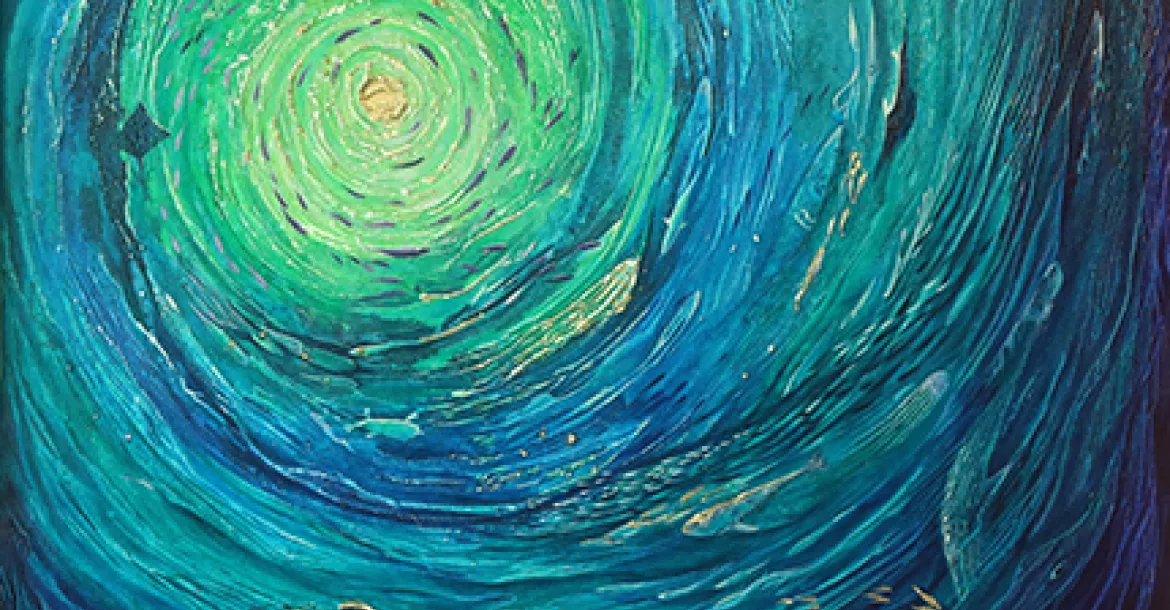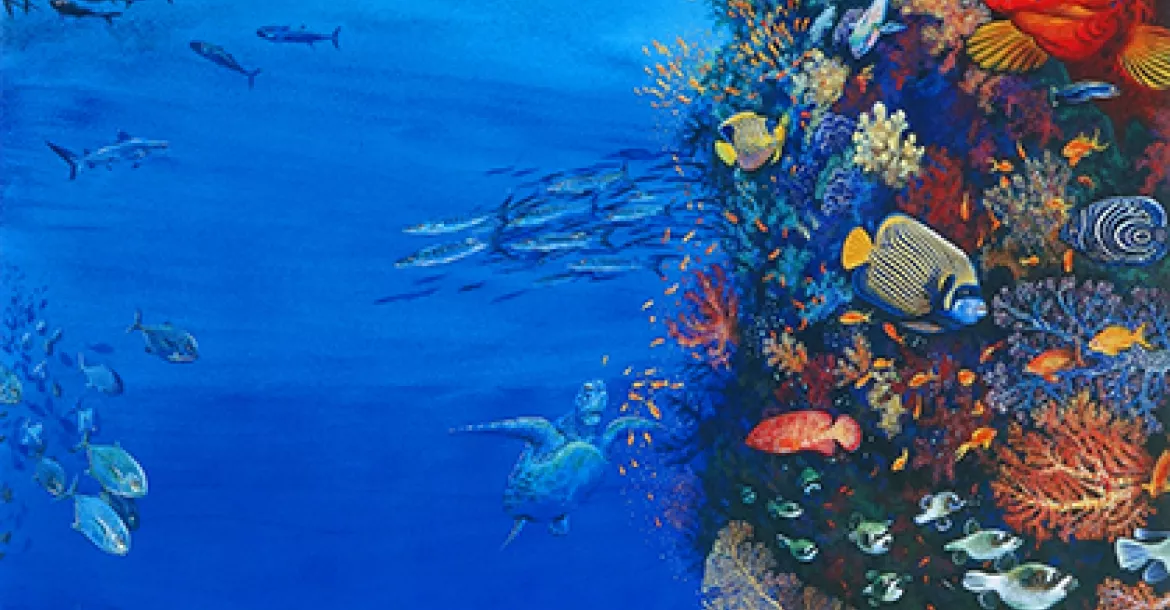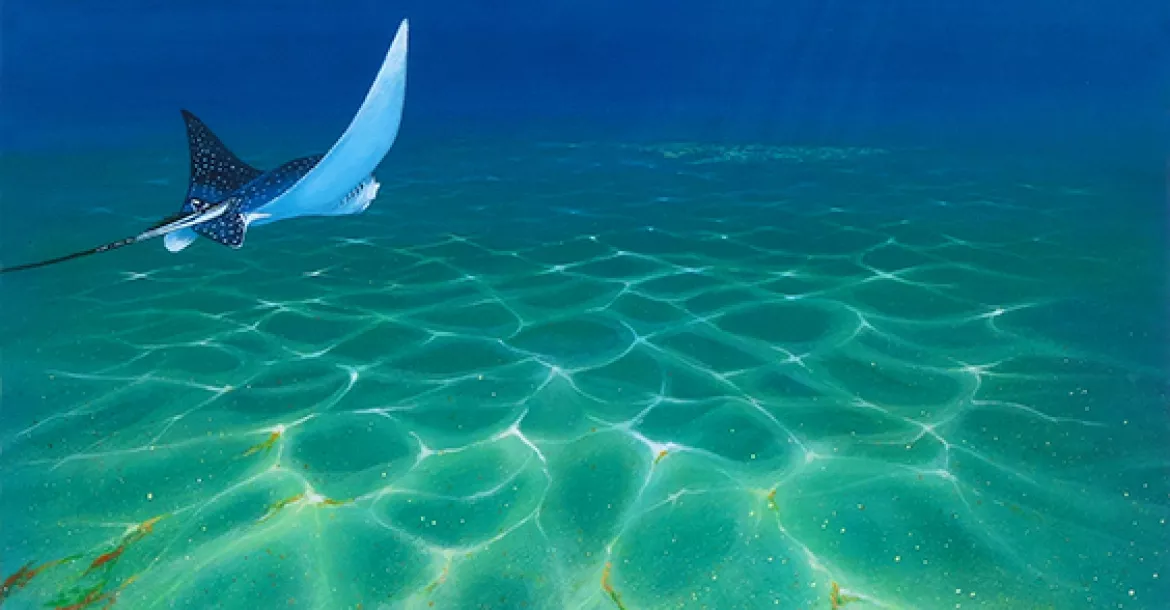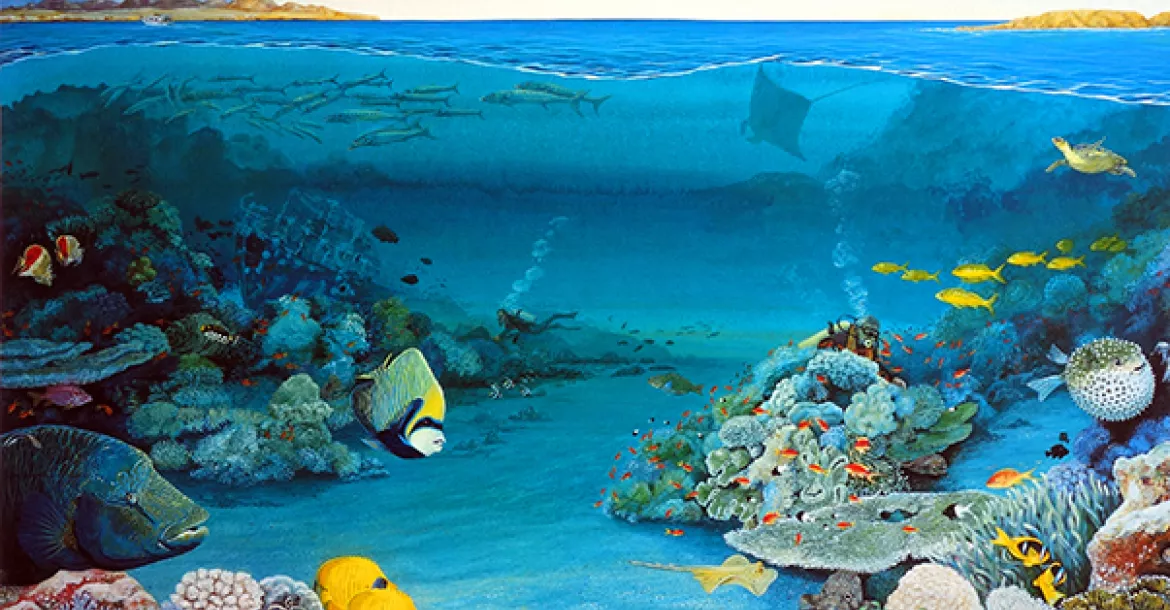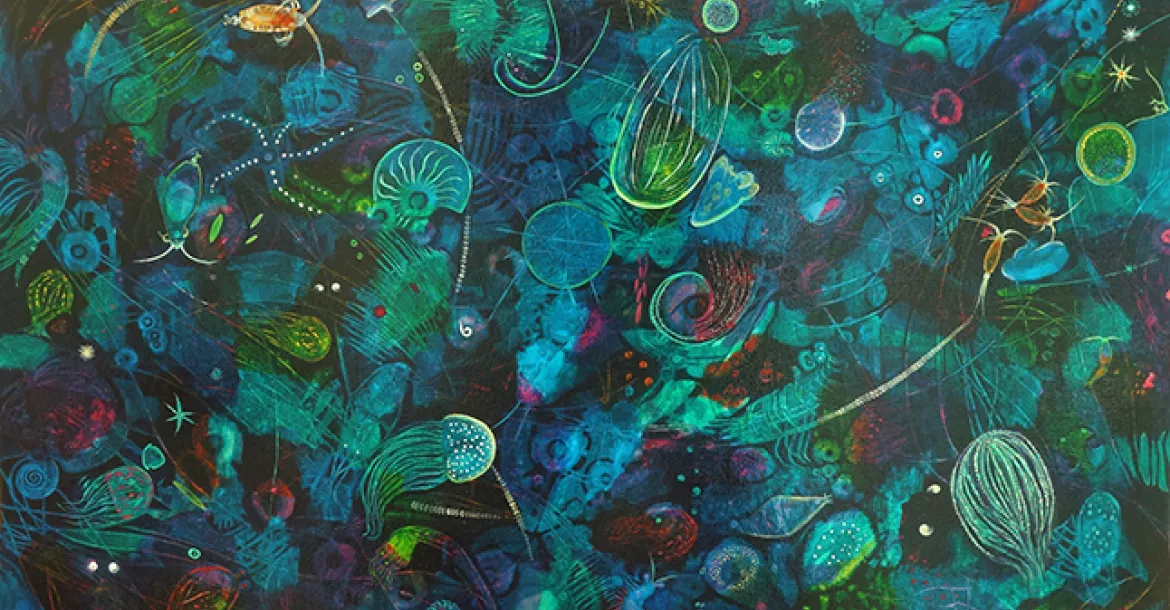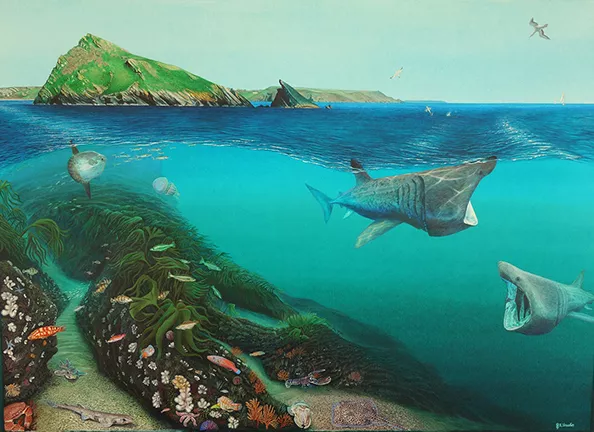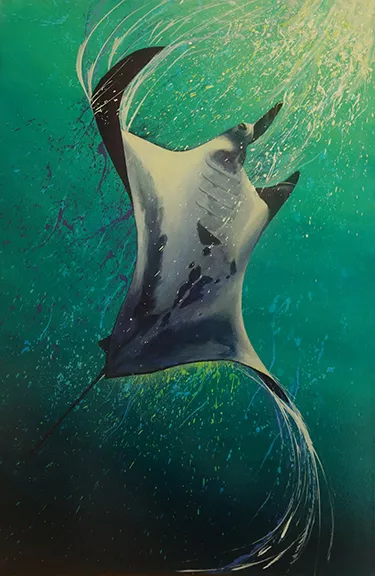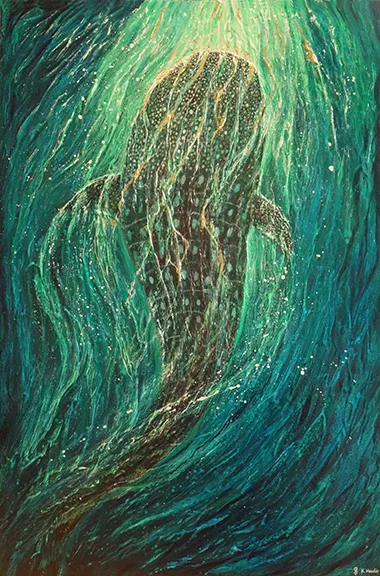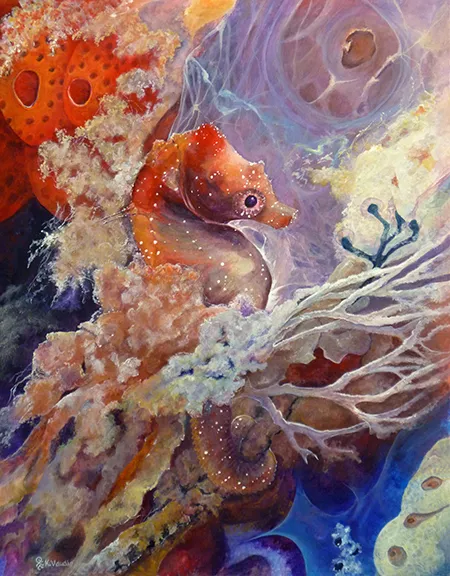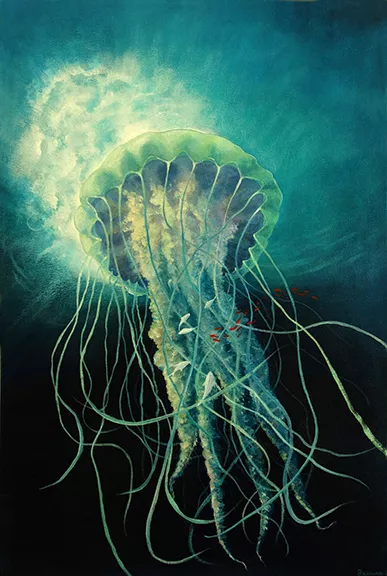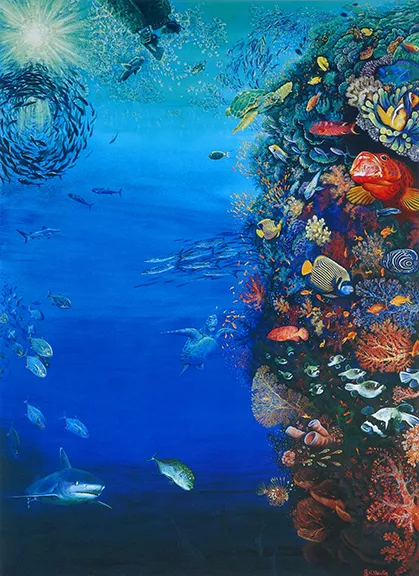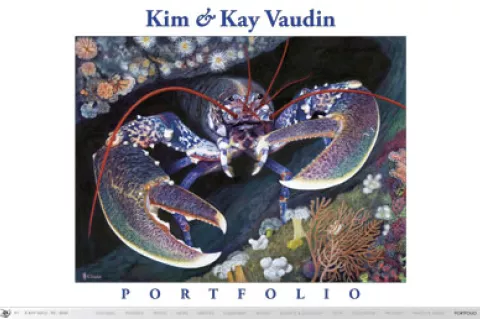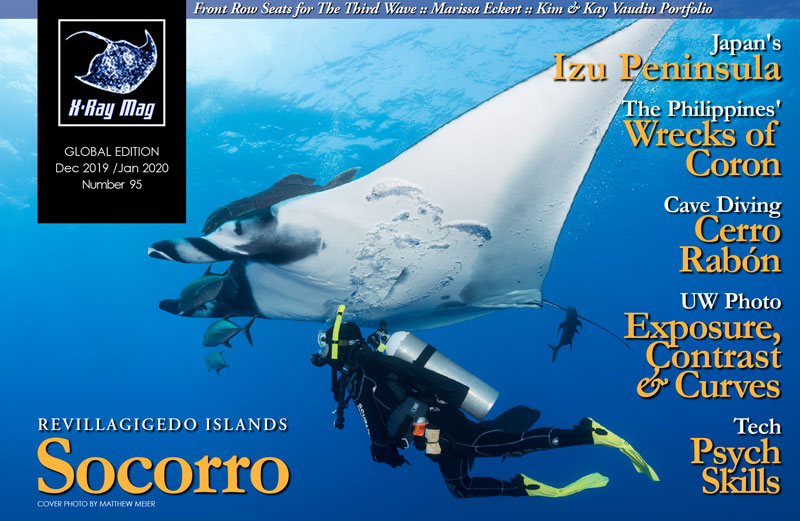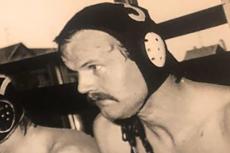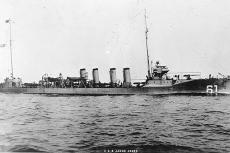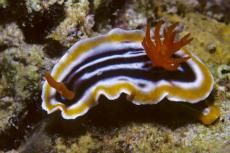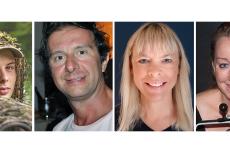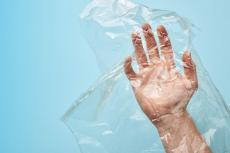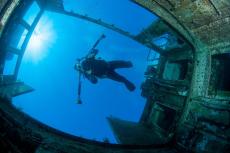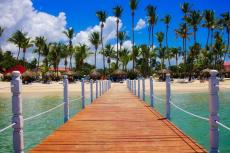
Kim & Kay Vaudin Portfolio
Mother-and-daughter team, Kay and Kim Vaudin, who are both divers and fine artists, often work together on canvases at their studio, Deep Impressions in the United Kingdom, to capture the dynamic effervescence and minute details of marine life as well as the sublime light and delicate ecosystems of the underwater world. X-Ray Mag interviewed Kim Vaudin to learn more about their artwork and their perspectives.
Contributed by
X-RAY MAG: Tell us about yourselves, your backgrounds, how you became artists and how you work together as artists.
KV: My family is originally from Guernsey, and we spent all of our summers on the beach and in the sea. I was 14 when I did my first dive with my dad guiding me down the harbour steps at Portelet. I did not realise it at the time, but it would shape the rest of my life. My father is a BSAC First Class Diver and Instructor, so the house was full of divers.
I loved their banter and stories of underwater adventures. Kay (my mum and fellow artist) would make their wetsuits and A flags. She was also well known for her potent homebrew, which fuelled many a raucous gathering around our kitchen table. The diving life was fascinating and infectious. So, after my degree, I travelled the world and worked my way around Australia so I could dive on the Great Barrier Reef. I can clearly remember the euphoria I felt on those dives to this day.
It was not until years later, after I had finished two years in art college, that I knew I had to try and combine this love of the sea with my urge to create. Using a Motormarine ll camera, my underwater photos of Plymouth Sound and the Red Sea were disappointing. I was never going to be able to capture the beautiful reefs and topside in one image. So,I decided the only way was to start painting.
My mum had always painted, and when I mentioned my ideas, she was in. It was a huge challenge. Weeks later, I completed my first British underwater painting, Beneath the Sound, while Kay’s Between the Reefs showcased the Red Sea where she loved to snorkel. We took a stand at the DIVE show in Olympia—absolutely the most nerve-wracking show I have ever done. Thankfully, our paintings were well received, and 20 years on, we are still exhibiting at the DIVE shows.
Working together has been invaluable as we will bounce ideas off of each other and discuss future projects. At times, it has tested our relationship, but we would not have missed a single minute of it.
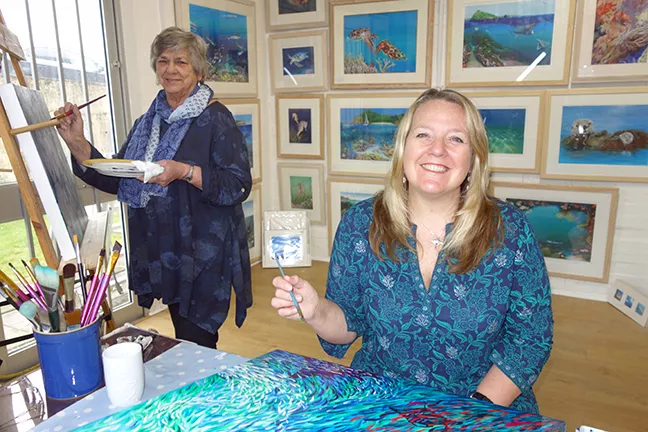
X-RAY MAG: Why marine life and underwater themes? How did you come to these themes and how did you develop your style of painting?
KV: We have always lived by the sea and love being in the water. Painting enhances this feeling and keeps this connection alive.
I particularly wanted to showcase all the wonderful British marine life we have on our doorstep. Unlike a photograph, painting gives us full control over the picture. Diving and snorkelling around the world have always inspired new paintings, and so our collection has grown.
Recently, we have expanded our style and have started exploring new techniques and mediums. Our latest work is much looser with a more abstract feel and has opened up a much wider audience to us. This is an ongoing process for both of us, so who knows what direction our work will take in the future?
X-RAY MAG: What is your artistic method or creative process?
KV: After making rough sketches, we stretch our paper then begin adding many layers of washes and background formations. Once the foreground is painted, all the creatures and detail can be added. It can take many days and even weeks to complete a painting.
Our new work on canvas is far more organic. We never know how they will come out and it is very freeing and exciting. We use a lot of different texture effects, adding tissue paper, fabric and mixing in sand, which I collect from the beach by our studio. This gives a 3D effect, and as we apply more layers, all kinds of creatures appear out of the texture.
Finally, once a painting is complete, we critique each other’s work. This has proved a crucial, if painful, part of the process, testing on our relationship. But it always results in a far stronger painting.
X-RAY MAG: What is your relationship to the underwater world and coral reefs? How have your experiences underwater influenced your art? In your relationship with reefs and the sea, where have you had your favourite experiences?
KV: For over 22 years, I have lived in Plymouth on a boat with my partner Mike, who is a marine biologist. We dive from our 43ft catamaran, as we have got some great sites and loads of life here. One memorable encounter was when we came across a huge common octopus fully out on a gully ledge, and I had forgotten to put the sim card in my camera!
Although I did get five shots of this beautiful creature in the internal memory, I was kicking myself. Another time, we found a massive torpedo ray, and as it lifted off the sand like a spaceship, I stretched my arms—it must have been over 5ft. But sometimes you cannot beat simply lying in the sand face-to-face with a cuttlefish—magic moments.
Topside, one of my best memories is jumping in with a basking shark off the Mewstone and finning like crazy trying to keep up with it. The fact that it defecated over my brother has etched this in my memory forever! So, when I painted the Mewstone Ledges, I had to include the basking sharks. Just off Guernsey this year, we came across large schools of bluefin tuna that were hitting the fish on the surface, it was amazing. That is definitely a painting for the future.
Every winter, we dive abroad, and after each trip, I always come back inspired and itching to get back to the easel. In Raja Ampat, we came across a huge school of fish being herded by a group of mobula rays. I felt like I was in the Blue Planet series. This dive alone inspired me to produce several paintings trying to capture the movement and light of being in this amazing fish ball.
We have been close to manta rays in many locations, but the giant mantas of Socorro were spectacular. In Yap, we enjoyed a two-hour dive alone in only six metres of water with mantas skimming over our heads and showing off for us.
We have been lucky enough to encounter hammerheads in several locations, but we never expected to see the sheer numbers that we saw in the Galapagos. There were hundreds racked up in the blue—pretty mind-blowing.
X-RAY MAG: What are your thoughts on ocean conservation and coral reef management and how does your artwork relate to these issues?
KV: As divers, we are extremely concerned about the state of our oceans, and in particular, the slaughter of headline species such as apex predators and manta rays. There have been many scientific studies that show that the economic value of these creatures is far higher alive than dead. So, it seems that the current trend of assigning a value to the environment has a lot of potential. It is alarming to think that, unless we act now on a global scale, the reefs and marine life could be so very different by the time my nieces and nephews are old enough to dive and explore the world for themselves.
I think that we have come a long way with regard to looking after our oceans and managing the seas within my lifetime. Attitudes have really changed, and this process has accelerated, at least in part, due to ground-breaking productions such as Blue Planet. However, there is still a long way to go, particularly with the major challenges of climate change, overfishing and plastic pollution.
We think it is important for everyone to realise that although the oceans face many issues, they are still full of life and definitely worth preserving. For example, earlier this year, we dived in Sudan, and we were amazed at the healthy condition of the pristine reefs inhabited by numerous fish, sharks and turtles. By continuing to paint such beautiful scenes, we hope to inspire the next generation to encourage them to interact with our seas and care for the life within them.
X-RAY MAG: What is the message or experience you want viewers of your artwork to have or understand?
KV: There are all kinds of reasons people connect with our work. Divers are often reminded of a particular dive or underwater experience. For others, they may simply love the sea and are drawn to a particular creature or just love bright colours. If, by looking at one of our paintings, people can escape even for a moment to a place where they feel more alive, then we have succeeded.
X-RAY MAG: What are the challenges or benefits of being artists in the world today? Any thoughts or advice for aspiring artists in ocean arts?
KV: I have found trying to get a balance between creating art, keeping inspired, managing a business and marketing is a juggling act. It is definitely something I am still working on. The main benefit has to be doing the thing you love. It does not feel like work at all. We are always thrilled when people we do not know buy our work because it enhances their lives in some way. It’s so gratifying.
To any aspiring artists out there, absolutely do it! You will always regret it if you do not try. Try to focus on the people who love and connect with your work. It is easy for a negative comment to block out all the good. Do not compare your work with others. There is room for everyone. And if you can gain any business and marketing experience along the way, this will be invaluable to you. It can be the most rewarding thing you will ever do.
X-RAY MAG: How do people—adults and children—respond to your works?
KV: We meet so many interesting people at shows and in the studio. We thrive on their reactions and thoughts on our art. Plus, we get to talk about the thing we love through our paintings.
We often get customers saying things such as, “That’s exactly like when I dived the Galapagos” or “It reminds me of my honeymoon in the Maldives.” Others simply need a painting to match their décor. It is fascinating to hear what they respond to in a painting.
Children get totally immersed in our work, especially when we are painting live at shows. Some can identify all of the fish in a picture absolutely correctly. One of our youngest fans is 10 years old and he badgered his mum for weeks for a print of the Mewstone Ledges for his birthday. We always talk to kids about diving and snorkelling and hope that they will be inspired to start themselves. They may be the marine biologists of the future.
X-RAY MAG: What are your upcoming projects, art courses or events?
KV: We will be painting and restocking for the Country Living Spring Fair at Alexandra Palace next April, which is an exciting new show for us. In between, we will hopefully take a dive trip to recharge our batteries and get inspired for the next series of work.
X-RAY MAG: Lastly, is there anything else you would like to tell our readers about yourself and your artwork?
KV: We recently opened our own working studio in Plymouth along with my brother, Dave, so it is a real family affair. He is not only an excellent picture framer, but he also makes these amazing wooden surfboards from scratch, which are finished with his own designs. My favourite design, naturally, is his mackerel board. If you are ever in Plymouth, please drop in. We would really love to see you. ■
For more information and to order prints, please visit the artists’ website at: deepimpressions.co.uk.
As divers, we are extremely concerned about the state of our oceans, and in particular, the slaughter of headline species such as apex predators and manta rays . . .
It is alarming to think that, unless we act now on a global scale, the reefs and marine life could be so very different by the time my nieces and nephews are old enough to dive and explore the world for themselves.
— Kim Vaudin
